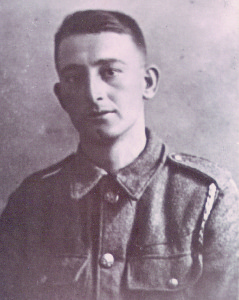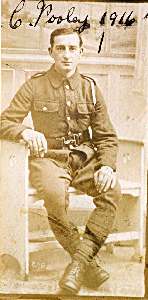
Photo: pooleydee

Photo: pooleydee
East Hedleyhope Welcome Home Fund Medallion Front
Medal Index Card
The Silver War Badge
They had 6 children, Susannah born January 1886, [who married James Gibbs, born 1877], George Henry born 1878, James 1880 - 1901, Thomas born 1881, William born 19th September 1883, all born at Waterhouses.
When her first husband Henry George Pooley died, Hannah remarried Matthew Johnson, born 1857 at Houghton-le-Spring.
In 1891 Charles was residing with his grandparents George and Sarah Pooley both aged 59. They resided at East Terrace, Brandon, Durham.
Charles married Mildred Bellis, [born Buckley, Wales in October? 1890], eldest daughter of Thomas, [born 1868, Buckley], and Agnes Bellis, [born 1871, Buckley], on the 29th May 1909, at St. Saviour's, Shotton Colliery, Durham. In 1911 they were residing at 18 Wilson Terrace, Haswell Moor, with their 10 month old daughter Hilda, born April 1910, died 1989, [who was in the WRAF in WW2]. The birth and death of son Charles June 1909 followed. George was born on the 28th April 1912, died 1999, married Nancy Turner, [born 17th June 1922, Wheatley Hill and died 14th January 2017, Shotton Colliery], and Vera Mills, born 25th November 1918, died 6th June 2009.
In 1939 they were still residing at Haswell Moor.
[Mildred in 1901 was residing at Pentre 29 The Arch, in Buckley in Flint, Wales].
Charles was a putter at the East Hedley Hope Colliery.
Charles Pooley enlisted into the 18th (Service), Battalion King's (Liverpool Regiment), 2nd City), 'Liverpool Pals'. on the 9th March 1915, was given the service number 057866 and the rank of private.
Formed in Liverpool on the 29th August 1914 by Lord Derby, in the old watch factory at Prescot. 30th April 1915, came under orders of the 89th Brigade, 30th Division.
Landed at Boulogne in November 1915, on the 25th December 1915, they were transferred to the 21st Brigade in the same Division.
On the 24th September 1917, the Battalion absorbed 16 officers and 290 men of the 1/1st Lancashire Hussars. This had previously been the VIII Corps Cavalry Regiment. Battalion became 18th (Lancashire Hussars Yeomanry) Battalion.
11th February 1918, they were transferred to the 89th Brigade in the same Division. On the 14th May 1918, they were reduced to cadre strength.
On the 19th June 1918, they were attached to the 66th (2nd East Lancashire) Division. On the 13th August 1918, they absorbed 14th Battalion and reformed. 19th September 1918, they were attached to 199th Brigade in the same Division.
On the 30th April the 18th Battalion were moved to Belton Park, prior they did their training at Hooton Park racecourse.Charles embarked for France on the 7th November 1915, arriving at Boulogne. In 1916 they took part in the Battle of the Somme,
Graham Maddocks's book "Liverpool Pals" shows that 18th were in 21st Brigade, 30th Division, on the extreme right of the British line. They were to attack on 1st July from assembly trenches to the east of Talus Boise, a jutting finger of woodland pointing towards German trenches below the SE corner of the fortified village of Montauban; objectives: Silesia Trench and Glatz Redoubt, 500 yards across no-mans land. The 30th Division front was defended by 6 Bayerische Reserve Infanterie-Regiment from Amberg. The 18th Battalion took their objective at heavy cost. and were in the Redoubt on 2nd July, but taken out of the line to the assembly trenches. On 3 July they had 6 officers and 288 men left. On the 8th July they were detailed as carrier battalion for the 21st Bde and moved up to Train Alley Trench where the CO, Col Trotter was killed. On the 8th [July] they captured and defended Trones Wood against counter-attack, at great cost and were relieved on the morning of the 9th - 28 of all ranks kia, wounded or missing.
1st July, The Capture of Montauban, 21st Brigade. Leading, with 19th Manchester's 18th King's went forward until they caught up with [the] British Barrage at Alt Trench, where they had to wait until the barrage lifted at 7.45am before occupying it. The Manchester's had few losses, but the King's were caught in enfiladed machine-gun fire from the west of Railway Valley. Fire from the 'Warren' caused severe casualties among [the] 2nd Green Howards who were in support, and a few managed to cross no man's land. A party of Germans came out of a deep dugout and proceeded eastwards but were out-bombed by a party of moppers-up. This enabled the 18th King's to advance along 'Train Alley' to 'Glatz Redoubt', reaching it at 8.35am and joining with 89th Brigade.
The First attacks on Trones Wood.
Saturday 8th July, Two companies of the 18th King's, and one of [the] 19th Manchester's helped to consolidate the position.
Source : The Day by Day account The Somme by Chris McCarthy ISBN 186019873. 1993.
We believe he was severely wounded about this time, and was a long time in recovery, he was at the 62nd Field Ambulance, and was convalescing at a Base Hospital, 13th General Hospital in Boulogne, where his wife visited him, he returned to the UK, but his wounds were serious, and was discharged from the Regiment Depot on the 12th April 1918. And was awarded the Silver War Badge nu 399267.
Paragraph 392 King's Regulations (xvi) No longer physically fit for war service. Army Order 265 paragraph 2b - those who, having served as soldiers and being still of military age, have been discharged under the conditions set forth at (i) and (ii) in (a): (i) after service overseas in the armed Forces of the Crown, on account of disablement or ill-health caused otherwise than by misconduct or (ii) after service at Home, and have been medically examined and finally discharged from liability to further military service under sub-section (5) of section 1 of the Military Service (Review of Exceptions) Act 1917, as permanently and totally disabled, otherwise than from misconduct. (i).
The Silver War Badge was issued in the United Kingdom to service personnel who had been honourably discharged due to wounds or sickness during World War I. The badge, sometimes known as the Discharge Badge, Wound Badge or Services Rendered Badge, was first issued in September 1916, along with an official certificate of entitlement. The sterling silver lapel badge was intended to be worn in civilian clothes. It had been the practice of some women to present white feathers to apparently able-bodied young men who were not wearing the King's uniform. The badge was to be worn on the right breast while in civilian dress, it was forbidden to wear it on a military uniform.
The badge bears the royal cipher of GRI (for Georgius Rex Imperator; George, King and Emperor) and around the rim "For King and Empire; Services Rendered". Each badge was uniquely numbered on the reverse. The War Office made it known that they would not replace Silver War Badges if they went missing, however if one was handed into a police station then it would be returned to the War Office. If the original recipient could be traced at his or her discharge address then the badge would be returned.
His first wife Mildred, ["Millie"], passed away in December 1920. On the 5th June 1922 he married for the second time at the Easington Register Office to Hannah Mills, [born 7th December 1891, Sherburn Hill, Durham, daughter of Abraham James Mills], and birth of their daughter Lilian followed on the 28th December 1922, died 1990.
On his return home he received from the East Hedleyhope Welcome Home Fund a Gold Medallion which was presented to the members who safely returned home, as a token of their gratitude and thanks for their service.
He died on the 13th February 1929, at 18, Wilson Terrace, Haswell Moor, cause of death is given on the certificate as "Lymphosarcoma of Mediastinum".
Under Profession, he's described as "Surface Worker at coal mine".
Research : James Pasby/Cynthia Kent
Acknowledgments : Dennis Pooley with thanks

